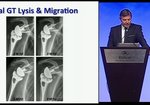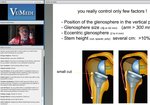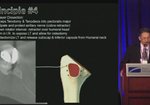Playback speed
10 seconds
Preoperative shoulder planning; data matrix and visualization
65 views
September 25, 2023
An educational research tool to stimulate discussion, Not intended for medical use;
On the AP ...
read more ↘ view, the fact that nodes C and G have significant contributions to both PC1 and PC2 suggests that they are nodes with strong influence on the overall variation in the dataset.
Node C is particularly interesting because it has a strong negative influence on PC1 and a positive influence on PC2, which means it has a unique combination of effects.
The clustering of nodes A, F, and B on PC1 suggests that they have similar effects on the variation captured by PC1.
The clustering of nodes C and G on PC2 suggests that they have somewhat similar effects on the variation captured by PC2. Explained Variance Ratios:
PC1 explains 89% of the total variance.
PC2 explains 6% of the total variance.
Node Contributions:
Node G has a relatively lower contribution to PC1 (0.3458) and PC2 (0.2952) compared to some other nodes.
Pairs of Nodes:
Node G is part of several pairs, but none of these pairs have the highest contribution to PC1 or PC2. For example, the pair ('C', 'F') contributes the most to PC1, and the pair ('D', 'A') contributes the most to PC2. data points associated with node G do not exhibit a significant spread or variation along PC1 and PC2, which is why there may not be a visible ellipse around node G. This suggests that node G is not a distinct cluster in this two-dimensional PCA representation; instead, it appears to be less influential in terms of explaining the variation captured by PC1 and PC2 compared to other nodes.
---
A dendrogram is a tree-like diagram used in hierarchical clustering to visualize the arrangement of data points (or objects) in a hierarchical manner. A dendrogram can help visualize a hierarchical relationship. The lines connecting nodes in a dendrogram are called "branches" or "linkages." These branches show how data points are grouped or clustered together based on their similarities. The height or length of a branch represents the degree of dissimilarity between clusters. Shorter branches indicate that the data points are more similar, while longer branches indicate greater dissimilarity.
------
In a K-means clustering result, nodes are assigned to clusters based on their proximity to cluster centers. If nodes C and G are in cluster 1, nodes A and F are in cluster 2, and nodes B, D, and E are in cluster 0, it means that, according to the clustering algorithm, these nodes are more similar to other nodes within the same cluster than to nodes in different clusters based on the features used for clustering (in this case, PC1 and PC2 scores).
↖ read less
On the AP ...
read more ↘ view, the fact that nodes C and G have significant contributions to both PC1 and PC2 suggests that they are nodes with strong influence on the overall variation in the dataset.
Node C is particularly interesting because it has a strong negative influence on PC1 and a positive influence on PC2, which means it has a unique combination of effects.
The clustering of nodes A, F, and B on PC1 suggests that they have similar effects on the variation captured by PC1.
The clustering of nodes C and G on PC2 suggests that they have somewhat similar effects on the variation captured by PC2. Explained Variance Ratios:
PC1 explains 89% of the total variance.
PC2 explains 6% of the total variance.
Node Contributions:
Node G has a relatively lower contribution to PC1 (0.3458) and PC2 (0.2952) compared to some other nodes.
Pairs of Nodes:
Node G is part of several pairs, but none of these pairs have the highest contribution to PC1 or PC2. For example, the pair ('C', 'F') contributes the most to PC1, and the pair ('D', 'A') contributes the most to PC2. data points associated with node G do not exhibit a significant spread or variation along PC1 and PC2, which is why there may not be a visible ellipse around node G. This suggests that node G is not a distinct cluster in this two-dimensional PCA representation; instead, it appears to be less influential in terms of explaining the variation captured by PC1 and PC2 compared to other nodes.
---
A dendrogram is a tree-like diagram used in hierarchical clustering to visualize the arrangement of data points (or objects) in a hierarchical manner. A dendrogram can help visualize a hierarchical relationship. The lines connecting nodes in a dendrogram are called "branches" or "linkages." These branches show how data points are grouped or clustered together based on their similarities. The height or length of a branch represents the degree of dissimilarity between clusters. Shorter branches indicate that the data points are more similar, while longer branches indicate greater dissimilarity.
------
In a K-means clustering result, nodes are assigned to clusters based on their proximity to cluster centers. If nodes C and G are in cluster 1, nodes A and F are in cluster 2, and nodes B, D, and E are in cluster 0, it means that, according to the clustering algorithm, these nodes are more similar to other nodes within the same cluster than to nodes in different clusters based on the features used for clustering (in this case, PC1 and PC2 scores).
↖ read less
Comments 0
Login to view comments.
Click here to Login




















